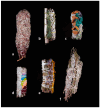Commercialized "Smudge Sticks" Used as Incense in the Netherlands: An Inventory of Plants and Trends Behind a New Age Fashion
- PMID: 39519920
- PMCID: PMC11547997
- DOI: 10.3390/plants13213003
Commercialized "Smudge Sticks" Used as Incense in the Netherlands: An Inventory of Plants and Trends Behind a New Age Fashion
Abstract
Incense is essential in religious ceremonies, even in relatively new religious and spiritual movements such as New Age and Neopaganism. These garner little attention from ethnobotanists, although they trigger an international trade in wild-harvested plants. In this paper, we studied the botanical ingredients of smudge sticks (dried plant bundles burned for purification) in the Netherlands, and people's motivations to use them posing the following questions: what plant species are included in smudge sticks? what are they used for? and are exotic plants preferred over native Dutch plant species? We visited online and physical shops in Dutch cities, acquiring a total of 29 different smudge sticks containing at least 15 species. We held semi-structured interviews with 11 users, vendors, and herbal experts, and collected data from 33 questionnaires. Salvia apiana L. was most frequently found, along with North American species of the genus Artemisia. The rise of the New Age movement resulted in North American ritual plant species being easily available in (online) shops in the Netherlands and smudge sticks being used for personal protection and cleansing. Despite the smudge sticks' commercial demand, there is no data regarding the pressure on wild populations of species used in these bundles. For the preservation of these species it is crucial that scientific monitoring of their harvest is undertaken in the future.
Keywords: California; Ethnobotany; Europe; Native American; Neo Paganism; United States; Wicca; cultural appropriation; ritual plants; witchcraft.
Conflict of interest statement
The authors declare no conflict of interest.
Figures



Similar articles
-
Incense and ritual plant use in Southwest China: a case study among the Bai in Shaxi.J Ethnobiol Ethnomed. 2011 Dec 13;7:43. doi: 10.1186/1746-4269-7-43. J Ethnobiol Ethnomed. 2011. PMID: 22165897 Free PMC article.
-
Monpa, memory, and change: an ethnobotanical study of plant use in Mêdog County, South-east Tibet, China.J Ethnobiol Ethnomed. 2020 Jan 30;16(1):5. doi: 10.1186/s13002-020-0355-7. J Ethnobiol Ethnomed. 2020. PMID: 32000826 Free PMC article.
-
The implications of ritual practices and ritual plant uses on nature conservation: a case study among the Naxi in Yunnan Province, Southwest China.J Ethnobiol Ethnomed. 2017 Oct 25;13(1):58. doi: 10.1186/s13002-017-0186-3. J Ethnobiol Ethnomed. 2017. PMID: 29065881 Free PMC article.
-
From forest to pharmacy: Should we be depressed about a sustainable Griffonia simplicifolia (Fabaceae) seed supply chain?J Ethnopharmacol. 2021 Oct 5;278:114202. doi: 10.1016/j.jep.2021.114202. Epub 2021 May 13. J Ethnopharmacol. 2021. PMID: 33991640 Review.
-
An updated inventory of medicinal and ritual plants of southern Africa.J Ethnopharmacol. 2024 Oct 5;332:118361. doi: 10.1016/j.jep.2024.118361. Epub 2024 May 17. J Ethnopharmacol. 2024. PMID: 38763369 Review.
References
-
- Guédon M.-F. Sacred smokes in circumboreal countries: An ethnobotanical exploration. North. Rev. 2000;22:29–42.
-
- Langenheim J. Plant Resins: Chemistry, Evolution, Ecology, and Ethnobotany. Timber Press; Portland, OR, USA: 2003.
-
- Chryssides G.D. Defining the New Age. In: Kemp D., Lewis J.R., editors. Handook of New Age. Koninklijke Brill NV; Leiden, The Netherlands: 2007. pp. 5–24.
-
- Cunningham S. The Complete Book of Incense, Oils & Brews. 1st ed. Llewellyn Publications; Woodbury, MN, USA: 1989. Forty-Fourth Printing 2021.
Grants and funding
LinkOut - more resources
Full Text Sources

